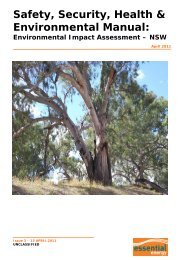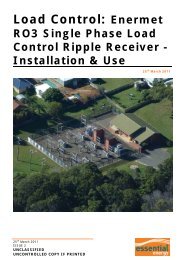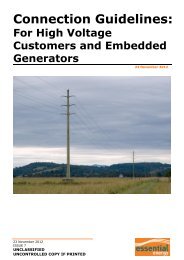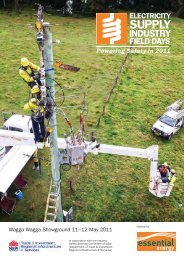Full Version - Essential Energy
Full Version - Essential Energy
Full Version - Essential Energy
You also want an ePaper? Increase the reach of your titles
YUMPU automatically turns print PDFs into web optimized ePapers that Google loves.
Detailed audit schedules have been developed to<br />
ensure all locations throughout the business are<br />
covered, and any potential safety hazards are identified<br />
and eliminated or minimised. Regular audits, coupled<br />
with corporate and regional safety initiatives, will ensure<br />
our goal of being a leader in safety.<br />
New team structure<br />
Our safety team has been restructured to form a<br />
dynamic team of multi-skilled people totally committed<br />
to creating a safer workplace.<br />
Chief Safety Officer Mark Mulligan was appointed to<br />
lift the profile of safety and deliver on our commitment<br />
to becoming Australia’s safest utility. Other changes<br />
focussed on the key areas of public safety, safety<br />
policy, audit and investigation and health services. New<br />
roles include Manager Public Safety, Manager Safety<br />
Policy Audit and Investigation, Manager Health Services<br />
and a dedicated project manager to assist with planning<br />
and performance and oversee the implementation of<br />
the new safety improvement plan.<br />
Another important development was the appointment<br />
of Regional Safety Coordinators (RSCs), to drive local<br />
safety improvements, ensure decisions are made<br />
quickly and efficiently and assist employees with safety<br />
related issues.<br />
Consultative committee reform<br />
The restructure of our safety committees has helped to<br />
provide a renewed focus on, and sense of ownership<br />
for, health and safety within the company. The reforms<br />
have been well received and feedback and participation<br />
has been very positive.<br />
The foundation of the committee structure is our Health<br />
and Safety Regional Improvement Groups (HASRIG),<br />
which are regionally-based groups that discuss<br />
local solutions and initiatives and focus on effective<br />
outcomes and resolutions.<br />
Any unresolved issues, topics of interest or regional<br />
actions are shared by the HASRIG chair people at<br />
Occupational Health and Safety Corporate Committee<br />
(OHSCC) meetings. This committee helps provide<br />
consistency and momentum to the HASRIGs and is<br />
chaired by an elected member of the HASRIG and<br />
atended by the Chief Safety Officer and other selected<br />
members of the Peak Health and Safety Steering Group<br />
(PHSSG).<br />
The PHSSG is chaired by the managing director and<br />
provides strategic direction to all committees. It is<br />
able to approve any proposed actions (requiring joint<br />
executive approval), review safety improvement plans<br />
and align policies with decisions resulting from HASRIG<br />
or OHSCC actions.<br />
Managing incidents and<br />
improvements<br />
All safety incidents and injuries are reported on a Works<br />
Improvement Notice (WIN) system, which has proven<br />
an effective tool in managing safety, environmental and<br />
network incidents, improvements and suggestions.<br />
The system was enhanced this year to link with<br />
our workers’ compensation system, ensuring more<br />
accurate reporting and investigation of incidents.<br />
The fact that employees are comfortable in reporting<br />
safety related matters is demonstrated by the fact<br />
that there were 837 safety related WINs raised (193<br />
incidents, 644 injuries) during 2004-2005. This was an<br />
increase on the 829 (188 incidents, 641 injuries) raised<br />
in 2003-2004.<br />
An incident investigation procedure was also developed<br />
to provide guidelines for investigating the root<br />
cause and contributing factors of safety incidents so<br />
subsequent corrective and preventative action can<br />
be taken. The procedure has already proved effective,<br />
identifying several corrective and preventative measures<br />
to assist in managing risks, and avoiding future safety<br />
incidents.<br />
Motor vehicle safety<br />
To reduce the number of motor vehicle accidents,<br />
several recommendations have been devised by an<br />
assigned team, which includes members of both the<br />
fleet and safety teams.<br />
Safety accessories, such as cargo barriers, reversing<br />
alarms, safety steps, first aid kits, fire extinguishers<br />
and night driving lights for ‘on call’ vehicles are being<br />
placed on new fleet and there is a strong focus on<br />
eliminating ‘at risk’ driving behaviours. An updated<br />
driver’s handbook has also been distributed, with<br />
changes including a new vehicle inspection checklist<br />
and information on what to do in a roadside breakdown,<br />
how to identify and avoid driver fatigue, tips for different<br />
driving conditions and driving and parking hazards.<br />
Future goals – 25 per cent reduction in motor vehicle<br />
accidents and deliver education campaign for all<br />
employees in 2005-2006.<br />
7<br />
COUNTRY ENERGY ANNUAL REPORT 2004–2005
















